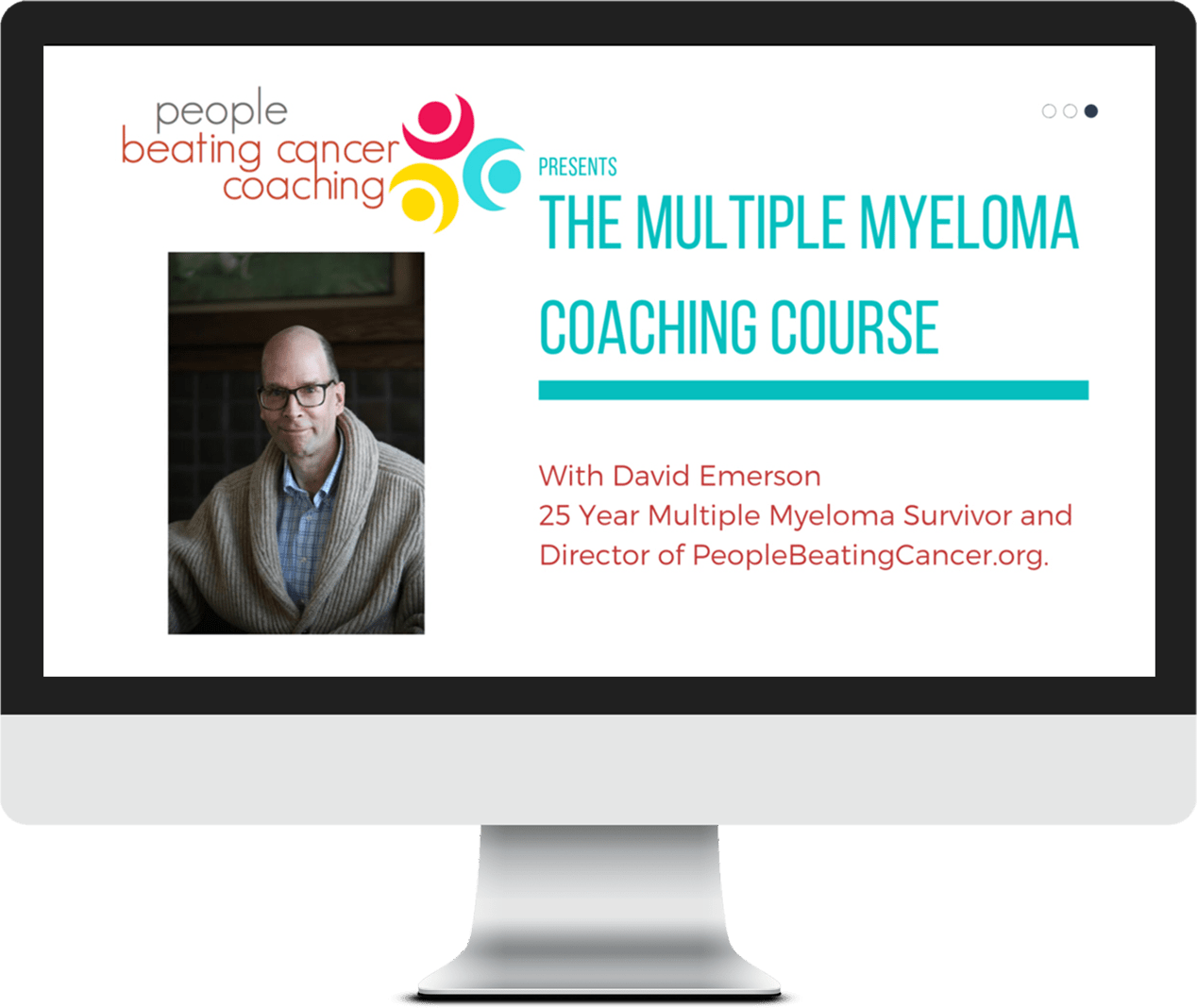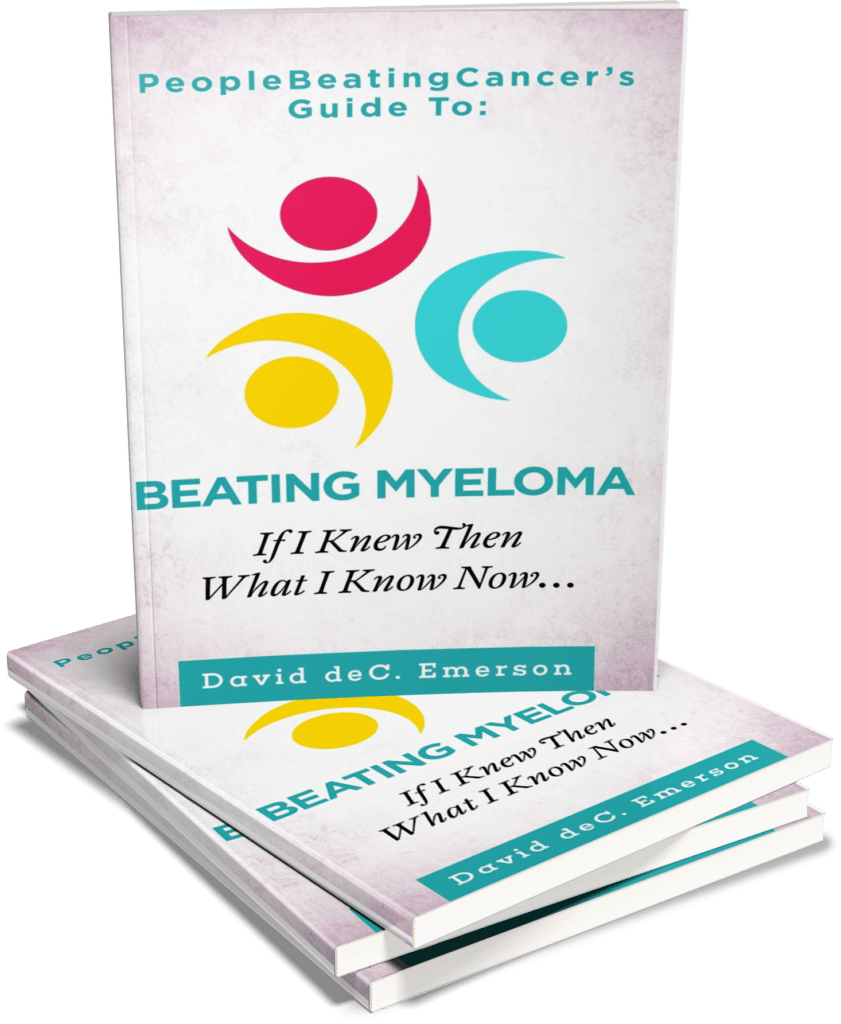Leave a Comment:
29 comments
Hello! Just diagnosed & so glad I found your site. Any advice is appreciated
ReplyHi Cindy-
I am sorry to learn of your MM diagnosis. What stage? How old are you? What symptoms are you experiencing?
David Emerson
Reply[…] Multiple Myeloma Therapy – Eight Slices of the Magic Bullet […]
ReplyHow do I get the book “Beating Myeloma”? I have had MM for three years. Also have renal failure so I am on dialysis. Doing well. Fatigue is my biggest problem.
ReplyDavid, you don’t have to reply! I just wish you 50 yrs of remission, if you aren’t naturally cured already. I’m doing ok considering the therapies not available to me. Chemo brain, I think, is a real thing. That’s all I have to say about that at this time.
Next week I have blood labs and of course I look forward to those anxiously..as usual.
Be Well, Please!
👍
Hi Kathryn- I always reply. This is what I do :-). Yes, chemobrain is real. Exercise, nutrition, etc. should help. We all get anxious when we are about to get blood work done. At least I do and it’s been years so…
Hang in there, David
Your program was a wonder, and I’m so grateful I stumbled across it in 2017 when I was first diagnosed. Still now no treatment! Thanks for your work.
ReplyTurmeric will it help kill myeloma cells ? I’ve added Turmeric with bioperine total daily 2500mg daily with 1000mg AM & PM 500mg with Ginger & Bosweilla mid day. My kappa light chain has went down since adding it so I think for this Kappa light variant its helping. Also, on velcade, & xpovio which causes Alot of nausea fastro upset for Days 1 & 2 ginger & nausea meds general & Lorazapam 45mins prior to Xpovio & Phenergan every 5½ after & Lorazapam every 8hrs, until it calms. Protein drinks, honey water & toast, banana or oatmeal for just Day 1 & 2
ReplyHi Michelle-
Sounds like you are working hard to manage your MM. Well done!
David Emerson
Reply[…] Multiple Myeloma Therapy – Eight Slices of the Magic Bullet […]
Reply[…] Multiple Myeloma Therapy – Eight Slices of the Magic Bullet […]
Reply[…] Multiple Myeloma Therapy – Eight Slices of the Magic Bullet […]
Reply[…] Multiple Myeloma Therapy – Eight Slices of the Magic Bullet […]
Reply[…] Multiple Myeloma Therapy – Eight Slices of the Magic Bullet […]
Reply[…] Multiple Myeloma Therapy – Eight Slices of the Magic Bullet […]
Reply[…] The Ultimate Multiple MyelomaTherapy – Eight Slices of the Magic Bullet […]
Reply[…] The Ultimate Multiple MyelomaTherapy – Eight Slices of the Magic Bullet […]
Reply[…] The Ultimate Multiple MyelomaTherapy – Eight Slices of the Magic Bullet […]
Reply[…] The Ultimate Multiple MyelomaTherapy – Eight Slices of the Magic Bullet […]
Reply[…] The Ultimate Multiple MyelomaTherapy – Eight Slices of the Magic Bullet […]
Reply[…] The Ultimate Multiple MyelomaTherapy – Eight Slices of the Magic Bullet […]
Reply[…] The Ultimate Multiple MyelomaTherapy – Eight Slices of the Magic Bullet […]
Reply[…] The Ultimate Cancer Therapy – Eight Slices of the Magic Bullet […]
Reply[…] The Ultimate Cancer Therapy – Eight Slices of the Magic Bullet […]
Reply[…] The Ultimate Cancer Therapy – Eight Slices of the Magic Bullet […]
Reply[…] the post The Ultimate Cancer Therapy – Eight Slices of the Magic Bullet I made a case for evidence-based non-toxic therapies to reduce the risks of cancer. I think it […]
Reply[…] The Ultimate Cancer Therapy – Eight Slices of the Magic Bullet […]
Reply[…] inflammation in people and increased inflammation increases the risk of cancer. While there are many evidence-based, non-toxic therapies shown to reduce the risk of various cancers including nutrition, exercise, detox, and others, one way to reduce your risk of […]
Reply


